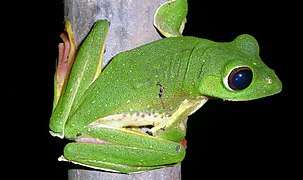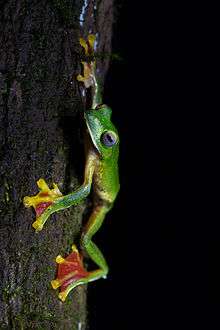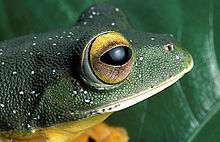Malabar gliding frog
The Malabar gliding frog or Malabar flying frog (Rhacophorus malabaricus) is a rhacophorid tree frog species found in the Western Ghats of India.
| Malabar gliding frog | |
|---|---|
 | |
| Scientific classification | |
| Kingdom: | Animalia |
| Phylum: | Chordata |
| Class: | Amphibia |
| Order: | Anura |
| Family: | Rhacophoridae |
| Genus: | Rhacophorus |
| Species: | R. malabaricus |
| Binomial name | |
| Rhacophorus malabaricus Jerdon, 1870 | |
 | |
Behavior

.jpg)
The term "gliding" frog refers to its ability to break its fall by stretching the webbing between its toes when making leaps down from the treetops. It can make gliding jumps of 9–12 m, a maximum of about 115 times its length.
Description

This frog has a body length of about 10 cm (4 in), making it one of the largest moss frogs. Males are smaller than females. Its back skin is finely granulated and the color is vivid green without markings, distinguishing it from the otherwise quite similar R. pseudomalabaricus, which has a black-marbled back and was long included in the present species.[1] In preserved specimens, the back turns purplish blue. The belly is more coarsely granulated – particularly under the thighs – and pale yellow. There are skin fringes between and along the long limbs, and a triangular skin extension at the heel. The webbing between fingers and toes is large and orange-red.[2]
The vomerine teeth are arranged in two straight or slightly oblique series touching the inner front edge of the choanae. The snout is rounded but not very wide, about as long as the diameter of the orbit, the canthus rostralis is bluntly-angled, and the loral region is concave. The nostrils are located nearer to the end of the snout than to the eyes. The interorbital space is broader than the upper eyelid. The tympanum measures about 60–70% of the diameter of the eye.[3]
The disks of fingers and toes are large, about the size of the tympanum; the subarticular tubercles are well-developed, also. The tibio-tarsal articulation reaches at least to the eye, at most top the nostril.[3]
Reproduction
Like many moss frogs, they build foam nests above small pools of water, into which the tadpoles drop after hatching.[4]
 Malabar gliding frogs in amplexus: Note much smaller male on top. |
A foam nest built by a gliding frog. |
See also
Footnotes
- E.g. by Boulenger (1890)
- Boulenger (1890), Bordoloi et al. (2007)
- Boulenger (1890)
- Kadadevaru and Kanamadi (2000)
References
- Biju, S.D.; Dutta, S.; Vasudevan, K.; Srinivasulu, C. & Vijayakumar, S.P. (2004). "Rhacophorus malabaricus". The IUCN Red List of Threatened Species. IUCN. 2004: e.T59001A11864773. doi:10.2305/IUCN.UK.2004.RLTS.T59001A11864773.en. Retrieved 9 January 2018.
- Bordoloi, Sabitry; Bortamuli, Tutul and Ohler, Annemarie (2007): Systematics of the genus Rhacophorus (Amphibia, Anura): identity of red-webbed forms and description of a new species from Assam. Zootaxa 1653: 1–20. PDF abstract and first page
- Boulenger, George Albert (1890): 56. Rhacophorus malabaricus. In: Fauna of British India – Reptilia and Batrachia: 473. Taylor and Francis, London. DjVu fulltext
- Kadadevaru, Girish G. and Kanamadi, Ravishankar D. (2000): Courtship and nesting behaviour of the Malabar gliding frog, Rhacophorus malabaricus (Jerdon, 1870). Curr. Sci. 79(3): 377–380 PDF fulltext
External links
| Wikimedia Commons has media related to Rhacophorus malabaricus. |
